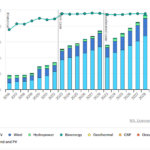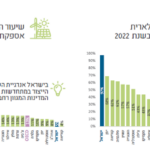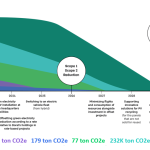-
- Developing and generating for our planet
- Doral’s Contribution to Reducing Emissions and Addressing for Climate Change
-
Innovation
Full chapter- Innovation
- A Leader in Israel’s Energy Storage Sector
- Doral Tech – Energy of Innovation
- A Bridge to Academia and Future Technologies
- Leading the Field of Dual-Use Renewable Energy Production in Israel
- Development of ‘Green Hydrogen’ Projects
- Development and Management of Environmental Infrastructure Integrated with Renewable Energy
- At the Forefront of Israel’s Green Electricity Market
- Reducing Water Consumption
- Preserving Biodiversity
- Waste Treatment and Promotion of Circular Economy
- Our Overall Environmental Impact – Greenhouse Gas Emissions Data
- Progress Against Targets
-
-
- Responsible and Ethical Management of Our Business
-
Corporate Management at Doral
Full chapter - Corporate Governance for ESG
- Business Ethics and Compliance at Doral
- Preventing Bribery, Corruption, and Conducting Internal Audits
- Information Security and Business Continuity
- Risk Management
- Responsibility in Our Value Chain
- Progress Against Our Targets
-

Developing and generating for our planet
The Forecast: Renewable Energy Expected to Address Approximately 76% of Global Electricity Production by 2050
In line with the global trend to reduce greenhouse gas emissions that contribute to global warming, many countries, including Israel, the United States, and some European countries, are encouraging the establishment of facilities for generating electricity from renewable energy, supporting evolving regulatory standards in the energy sector.
To the best of the Company’s knowledge, and as of publication of this report, more than 190 countries worldwide promote policies that support electricity generation from renewable energy sources. According to Bloomberg’s research (BNEF), based on the Economic Transition Scenario (ETS) – which relies on technology and market competition without any policy intervention – renewable energy is expected to supply about 76% of global electricity production by 2050. Based on the ETS scenario, solar and wind energy will constitute approximately 65% of electricity production by 2050, with an additional 20,000 gigawatts of solar, wind, and energy storage facilities expected by that year.1
Furthermore, based on reports, low-carbon sources currently account for about a third of the global electricity production capacity (including approximately 26% from renewable energy and about 10% from nuclear energy), while the remaining two-thirds of global electricity production capacity result from the burning of fossil fuels, such as coal, gas, and oil, which emit greenhouse gases.2 In the U.S., approximately 22% of the electricity produced in 2023 was generated from renewable energy sources, about 59% from fossil fuels, and about 19% from nuclear energy.3 In Europe, approximately 44% of the electricity produced in 2023 was generated from renewable energy, less than 33% from fossil fuels, and the remainder from nuclear energy.4
Numerous companies are also joining the global effort. Nearly 400 international corporates have set a goal of consuming 100% renewable energy by 2050 as part of the RE100 initiative.5 Achievement of these targets necessitates innovative developments to address existing challenges, and we see great importance in supporting this positive trend.
Global energy mix data indicates that the application of renewable energy solutions will continue to grow as a solution to environmental needs and energy consumption demands.
The global development and use of solar energy are driven by cost reductions, technological innovations, large-scale projects, distributed systems, supportive policies, improved grid integration, and widespread deployment in many countries. These trends position solar energy as a key contributor in the transition to a sustainable and carbon-free energy future.
Renewable electricity capacity additions by technology and segment, 2016-2028

Source: IEA
In addition, according to the Energy Sector Status Report by the Ministry of Energy and Infrastructure, the primary source of renewable energy in Israel is solar power, and the rate of solar energy use in Israel is high compared to developed countries. However, due to the limitations of solar energy, the total use of renewable energy in Israel is relatively low compared to developed countries, where wind, hydroelectric power, and other renewable sources are also utilized. However, the installed capacity of renewable energy continues to grow to meet the Israeli government’s target of 30% electrical production from renewable sources by 2030.

Image on right:
Rate of Solar Energy Use as a Percentage of Total Renewable Energy in 2022
Israel leads globally in the percentage of solar energy out of the total renewable energy.
Image on left:
Rate of Renewable Energy Use in Total Primary Energy Supply in 2022
In Israel, solar energy constitutes the majority of renewable energy production, while in other countries, the energy mix is more diverse.
Doral, as a pioneer of solar energy in Israel, is committed to preserving the natural environment by integrating environmental, land-based, social, and economic considerations in decision-making processes and all areas of the Company’s activity, ensuring environmental quality for present and future generations.
While our core business inherently supports the environment, it is our responsibility to implement environmental sustainability throughout our entire value chain. We comply with environmental regulations in all the countries where we operate and work alongside consultants and regulatory representatives to maximize environmental protection values. During the establishment and operation of facilities at our sites, we consider their impact on the local flora and fauna and create mechanisms to mitigate potentially harmful consequences. We explore development and investment in innovative recycling solutions for the waste generated from the use of solar panels, inverters, and batteries, including through the activities of Doral Tech.
Doral believes that the initiation, development, and establishment of renewable energy systems aim to meet the needs of both humanity and the environment while preserving resources and reducing pollutants for the benefit of future generations.
In addition, the Company, through its subsidiaries – Doral Environmental Infrastructure, Doral Tech, and Doral Green Hydrogen – works to develop and promote innovative, environmentally sustainable technologies and ensure their application in projects and ventures. These applications are environmentally empowering, influencing the reduction of polluting energy consumption and greenhouse gas emissions, efficient water consumption, and minimizing pollution caused by waste and effluents.
For example:
- Investment in a company for recycling lithium batteries that have reached end-of-life.
- Initiating and developing projects for producing green hydrogen using green energy.
- The Company’s biogas systems provide a comprehensive solution for agricultural waste, livestock manure, and organic waste, as an alternative to transporting and burying waste in landfills, which occupy extensive areas and create various environmental hazards.
Our commitment to promoting environmental sustainability is demonstrated in the Group’s policy on our website.
Our targets in this field are:
- Net Zero – by 2030
- Initiating and developing dual-use land projects, primarily agro-voltaic
- Initiating and developing projects for producing green hydrogen
- Creating business collaborations between Doral Tech’s portfolio companies and the Company’s business units
Commitment to Net-Zero by 2030
Doral was founded on principles of environmental sustainability through its focus on implementing renewable energy, green energy, and innovative solutions in the field. The Company’s mission is to continue contributing to the reduction of greenhouse gas emissions and the climate crisis in Israel and globally, by producing clean energy and fostering the development of ‘clean‘ technologies and processes. To this end, the Company has set an ambitious goal to achieve Net Zero by 2030.
To achieve this goal, and in line with Doral’s commitment in this area, the Company has formulated a decarbonization plan aimed at presenting a roadmap to achieving our target. This roadmap will serve as a public, binding, and guiding document to ensure implementation of the plan. The document was formulated based on the principles of Science-Based Targets (SBTi), as part of the Company’s preparation for future participation in the initiative.
The Roadmap to Achieving the Company’s Goals:




